A Complete Guide to the Original 6 NHL Teams
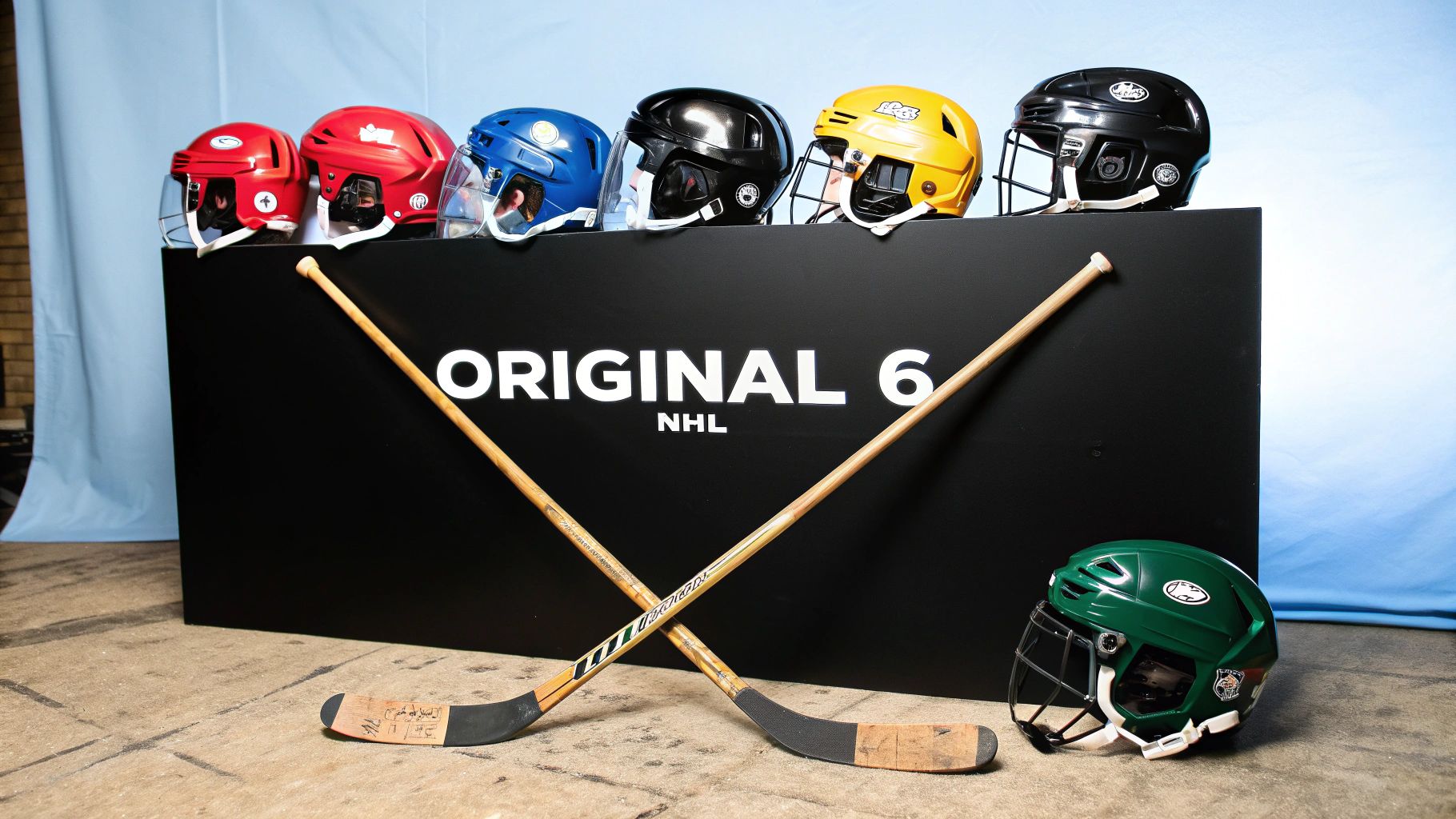
When someone talks about the Original 6 NHL teams, they're referring to a legendary chapter in hockey history. This group consists of six iconic franchises: the Montreal Canadiens, Toronto Maple Leafs, Boston Bruins, Chicago Black Hawks, Detroit Red Wings, and New York Rangers.
This crew defined the league for a solid 25-year stretch from 1942 to 1967, an era famous for its brutal rivalries and for laying the foundation of modern professional hockey.
Unpacking the Legend of the Original 6
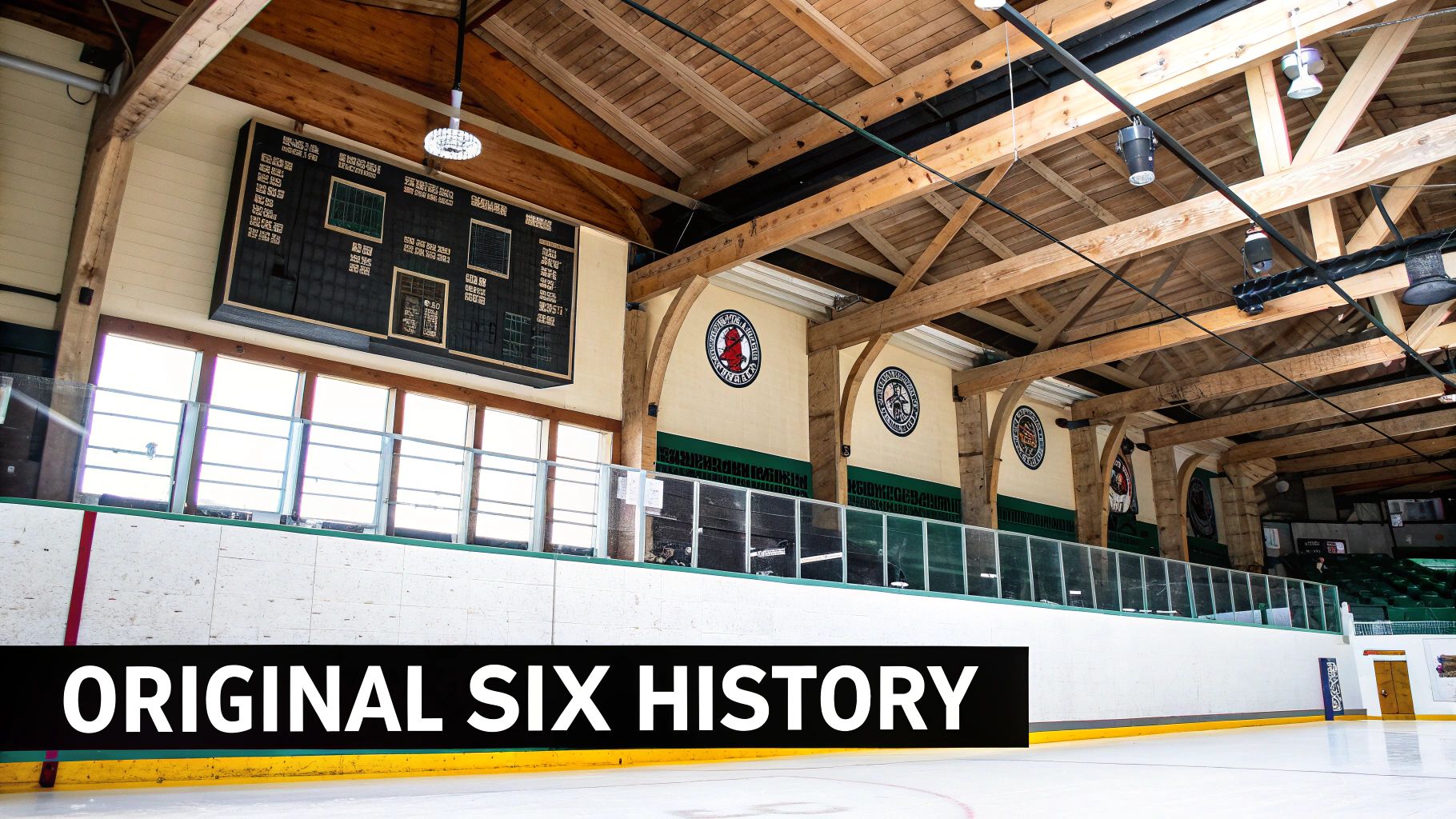 For hockey fans, the term "Original 6" brings up black-and-white images of legendary players, classic wool sweaters, and the kind of old-school grit you just don't see anymore. But there's a common misunderstanding that these were the very first six teams to ever join the National Hockey League.
For hockey fans, the term "Original 6" brings up black-and-white images of legendary players, classic wool sweaters, and the kind of old-school grit you just don't see anymore. But there's a common misunderstanding that these were the very first six teams to ever join the National Hockey League.
The truth is a little more complicated. The league saw a number of teams come and go in its wild early decades.
The "Original 6" label doesn't actually mean they were charter members from the NHL's founding in 1917. Instead, it points to a uniquely stable and defining period in the sport's history. This era kicked off in the 1942-43 season after the Brooklyn Americans folded, leaving just these six teams standing. For the next quarter of a century, they were the entire league.
The Foundation of Modern Hockey
That 25-year run, from 1942 until the league doubled in size in 1967, became the bedrock of the modern game. It’s less of a "starting lineup" and more like the league's most formative chapter. Having only six teams created a pressure-cooker environment where familiarity didn't just breed contempt—it bred legendary hatred.
This era was instrumental because every game felt like a playoff battle. The players knew each other intimately—their strengths, weaknesses, and tendencies—which cultivated some of the most personal and heated rivalries in sports history.
Think about it: players faced the same opponents up to 14 times a season. That’s a world away from today’s 32-team league. This constant repetition is what forged the incredible stories and rivalries that still resonate with fans today. The six franchises that defined this period are:
- Montreal Canadiens
- Toronto Maple Leafs
- Boston Bruins
- Chicago Black Hawks (now Blackhawks)
- Detroit Red Wings
- New York Rangers
An Era of Concentrated Talent
With every single NHL-calibre player in the world funnelled onto just six rosters, the level of talent was off the charts. Every team was a powerhouse, absolutely stacked with future Hall of Famers.
This incredible concentration of skill meant that winning the Stanley Cup was a monumental achievement, cementing the legacies of the dynasties that emerged. This period established these six teams not just as franchises, but as true pillars of the sport. Their history is woven directly into the DNA of the NHL itself.
The Golden Era: Hockey's 25-Year Dynasty
Imagine a sports league where you played the same five teams over and over again for 25 straight years. That wasn't a hypothetical—it was the reality of the Original Six NHL from 1942 to 1967. This quarter-century stretch wasn’t just a period of stability; it was a crucible that forged the league’s very identity, rightly earning its name as hockey's "Golden Era."
The stage was set by forces far beyond the rink. The Great Depression and World War II took a heavy toll on professional sports, forcing multiple franchises to fold. By the 1942-43 season, only six teams were left standing, creating an intense and intimate league structure out of sheer necessity.
This setup meant rivalries weren't just common; they were personal and unavoidable. Players didn't just compete against opponents; they knew their every move, grudge, and weakness over the course of up to 14 regular-season games each year.
Forging Legends Through Fierce Rivalry
That kind of intense familiarity bred some of the most legendary conflicts in hockey history. The on-ice battles between titans like Detroit's Gordie Howe and Montreal's Maurice 'The Rocket' Richard were more than just games—they were defining cultural moments. Their clashes were physical, bitter, and symbolic of a larger war for supremacy.
These individual duels were just a reflection of the team rivalries they represented. The animosity between the Montreal Canadiens and the Toronto Maple Leafs, or the Bruins and the Canadiens, became the stuff of legend. Every game felt like another chapter in an ongoing saga, fuelling a passionate and deeply loyal fan base that passed its allegiances down through generations.
This era was defined by its concentrated talent and intensity. With only about 120 roster spots in the entire league, every player was an elite talent, and every single game had the weight and feel of a playoff contest.
The "Original Six" NHL teams—the Boston Bruins, Chicago Black Hawks, Detroit Red Wings, Montreal Canadiens, New York Rangers, and Toronto Maple Leafs—were the only franchises in town from 1942 to 1967. Of this group, the two Canadian clubs, the Montreal Canadiens and Toronto Maple Leafs, hold a special distinction as charter members of the NHL, dating back to its founding in 1917. The Canadiens built a dynasty, snagging 10 of their record 24 Stanley Cups during this period, while the Maple Leafs captured their last championship in 1967, the final year of the era. You can discover more insights about this historic period and its impact on the NHL.
A Game Woven into Canadian Identity
Nowhere was this passion felt more strongly than in Canada. For fans in Montreal and Toronto, hockey was more than a sport; it was a piece of their cultural identity. The Canadiens stood for French-Canadian pride and flair, while the Maple Leafs embodied English-Canadian grit and tradition.
This dynamic turned every Saturday night into a national event. Families would huddle around the radio, and later the television, for Hockey Night in Canada—a ritual that connected communities from coast to coast. The players weren't just athletes; they were heroes and villains whose exploits were debated in schoolyards and workplaces all week long.
- Intense Competition: Facing the same teams over and over made every regular-season game feel like a high-stakes rivalry match.
- Iconic Superstars: The era produced legends like Howe, Richard, Bobby Hull, and Jean Béliveau, whose names are still revered today.
- Deep-Rooted Fan Bases: The stability of the six teams allowed for generations of fans to build an unwavering loyalty to their home clubs.
This 25-year dynasty did more than just keep the league afloat during tough times. It built the character, traditions, and legendary stories that still define the NHL. It was in this small, six-team pressure cooker that the gritty, resilient, and passionate spirit of professional hockey was truly born, creating a legacy that continues to shape the game today.
A Team-by-Team Breakdown of the Original 6
To really get the Original 6 NHL era, you have to understand the character of each club. These aren’t just six random teams; they’re storied franchises with identities hammered out over decades of heated rivalries. Each team brings a different flavour to the league’s history, from dynasty-level dominance to pure, blue-collar grit.
This breakdown takes a closer look at each legendary franchise. We’ll dig into their origins, their biggest moments during the 1942–1967 golden age, the icons who proudly wore their sweaters, and their ultimate legacy measured in Stanley Cups.
Before we dive into each team's story, here’s a quick look at how they stack up. This table summarizes their founding years and their championship success, both during the era and overall.
The Original 6 at a Glance
| Team | Founded | Stanley Cups (1942-1967) | Total Stanley Cups |
|---|---|---|---|
| Montreal Canadiens | 1909 | 10 | 24 |
| Toronto Maple Leafs | 1917 | 6 | 13 |
| Detroit Red Wings | 1926 | 4 | 11 |
| Boston Bruins | 1924 | 0 | 6 |
| Chicago Black Hawks | 1926 | 1 | 6 |
| New York Rangers | 1926 | 0 | 4 |
As you can see, the Canadiens and Leafs were the clear powerhouses of the era, but every team left its mark on the game in its own way.
Montreal Canadiens: The Flying Frenchmen
Any conversation about the Original 6 has to start with Les Habitants. The Montreal Canadiens are more than a hockey team; they’re a cultural pillar, especially for French-speaking Canada. Founded in 1909, they’re the oldest continuously operating pro hockey team in the world and the only club that existed before the NHL was even formed.
During the golden era, their identity was all about speed, skill, and just overwhelming offensive firepower. Known as the "Flying Frenchmen," they played a dazzling, up-tempo game that left opponents spinning. This period cemented their reputation as the league’s most decorated franchise.
The Canadiens' dominance over this 25-year stretch was just staggering. They reached the Stanley Cup Final 16 times and hoisted the Cup on 10 of those occasions—including an untouchable run of five straight titles from 1956 to 1960.
This dynasty was built on the backs of legends. Maurice "The Rocket" Richard was the fiery heart of the team, famously the first player to pot 50 goals in 50 games. Jean Béliveau brought pure class and leadership, while Doug Harvey basically reinvented how defencemen played the game. Their success was rooted in a level of skill few teams could ever hope to match.
Toronto Maple Leafs: Canada's Other Team
On the other side of Canada’s great hockey rivalry stood the Toronto Maple Leafs, a team with a history just as rich, but one defined by grit and a relentless work ethic. Founded in 1917 as the Toronto Arenas, they became the Maple Leafs in 1927 and quickly made themselves a perennial threat.
In the Original 6 era, the Leafs were Montreal's main adversary. While the Habs often won with finesse, Toronto’s game was built on toughness and a tight defensive structure. Their rivalry became the main event in Canadian sports—a clash of cultures and playing styles that had the whole country glued to their seats every Saturday night.
The Maple Leafs had massive success, winning six Stanley Cups between 1942 and 1967. Their most memorable stretch came in the 1960s when they won three straight championships from 1962 to 1964, plus one last improbable title in 1967, the final year of the era. Icons like Syl Apps, Ted Kennedy, and Dave Keon led the charge, perfectly embodying the team's hardworking spirit.
Detroit Red Wings: Hockeytown USA
The Detroit Red Wings were the top American club of the Original 6 era. Established in 1926, the team adopted the Red Wings name in 1932 and built a legacy of toughness and sustained excellence that earned Detroit its "Hockeytown" nickname.
Their identity was personified by one man: Gordie Howe. "Mr. Hockey" was the complete package—a scoring machine, a tough-as-nails competitor, and a durable icon who played an incredible 25 seasons in Detroit. His presence defined the franchise for an entire generation.
The Red Wings hit their peak in the early 1950s, building a powerhouse dynasty.
- Four Stanley Cups: They brought home championships in 1950, 1952, 1954, and 1955.
- The Production Line: The legendary trio of Howe, Sid Abel, and Ted Lindsay terrorized the league with their scoring and physical dominance.
- Goaltending Excellence: Terry Sawchuk, one of the greatest goalies ever, was the backbone of this dynasty, setting records for wins and shutouts.
The team’s success during this time cemented its status as one of the league's cornerstone franchises, building a passionate fan base that remains one of the most loyal in all of sports.
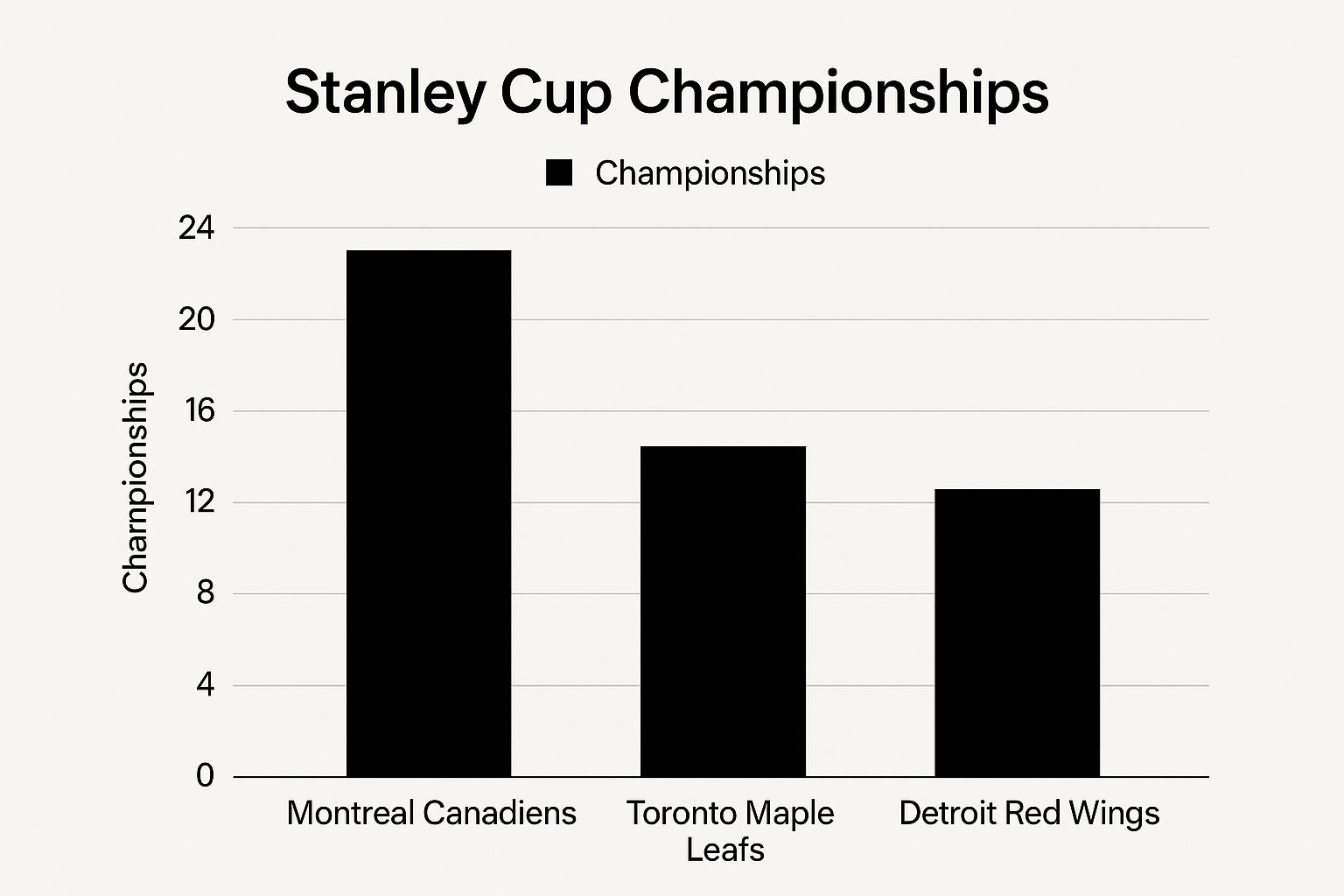
This chart really puts Montreal's historic dominance into perspective. With 24 championships, they have more than double the total of the third-place Red Wings.
Boston Bruins: The Big Bad Bruins
As the first American team to join the NHL back in 1924, the Boston Bruins have always played with a chip on their shoulder. Their identity is all about toughness, truculence, and a physical, in-your-face style of hockey that earned them the nickname "The Big Bad Bruins."
While they won Stanley Cups in 1939 and 1941, just before the Original 6 era officially kicked off, the 25 years that followed were a long, tough road for the franchise. They were often a competitive bunch but just couldn't get past the dynasties in Montreal and Detroit.
Even without championships in this specific window, the Bruins were never an easy two points. Players like Milt Schmidt, Woody Dumart, and Bobby Bauer—the famous "Kraut Line"—were stars in the early 1940s. Later on, legendary defenceman Eddie Shore set the standard for punishing physical play. Goaltending was a strong point, too, with Frank "Mr. Zero" Brimsek becoming a sensation. You can explore more about the pivotal role of goaltenders by looking into detailed analyses of NHL goalie save percentage metrics, which often tell the story of a team's fortunes.
The Bruins' true golden age was just around the corner, waiting for the arrival of superstars Bobby Orr and Phil Esposito. But the seeds of their hard-nosed identity were planted firmly during these formative years.
Chicago Black Hawks: The Innovators
The Chicago Black Hawks (the name was officially smashed into "Blackhawks" in 1986) joined the league in 1926 and spent a good chunk of the Original 6 era playing the underdog. For years, they were held back by poor management and struggled to keep up with the league's heavyweights.
But things took a dramatic turn in the late 1950s and 1960s, as the team transformed into a powerhouse. Their identity shifted to a thrilling, high-speed offence led by two of the most electrifying players of their generation.
- Bobby "The Golden Jet" Hull: With a blistering slap shot and unbelievable speed, Hull was a scoring machine and the first player to break the 50-goal barrier in a season.
- Stan Mikita: A brilliant playmaker and two-way forward, Mikita was one of the smartest and most skilled players of his time.
This dynamic duo powered Chicago to a Stanley Cup victory in 1961, snapping a 23-year championship drought. Their exciting brand of hockey packed Chicago Stadium and made the Black Hawks one of the most popular teams in the league, cementing their place among the NHL's elite.
New York Rangers: The Broadway Blueshirts
Rounding out the Original 6 are the New York Rangers. Playing in the heart of America's biggest city, the "Broadway Blueshirts" have always carried a unique flair and the pressure to perform under the bright lights of Madison Square Garden.
The Rangers, who joined the league in 1926, found success right away, winning the Stanley Cup in just their second season. They won another championship in 1940, but that victory would be their last for 54 long years, kicking off a period of struggle that pretty much defined their Original 6 era.
Despite the team's lack of championships, they were never short on star power. Goalie Chuck Rayner won the Hart Trophy as league MVP in 1950—a rare feat for a player on a non-playoff team. Andy Bathgate was a world-class forward who won the Hart in 1959, and smooth-skating defenceman Harry Howell took home the Norris Trophy in 1967.
The Rangers were consistently competitive but always seemed to fall just short, making them a tragic but beloved franchise. Their story during this era is one of resilience and star power, even without the ultimate prize.
The End of an Era and the 1967 NHL Expansion
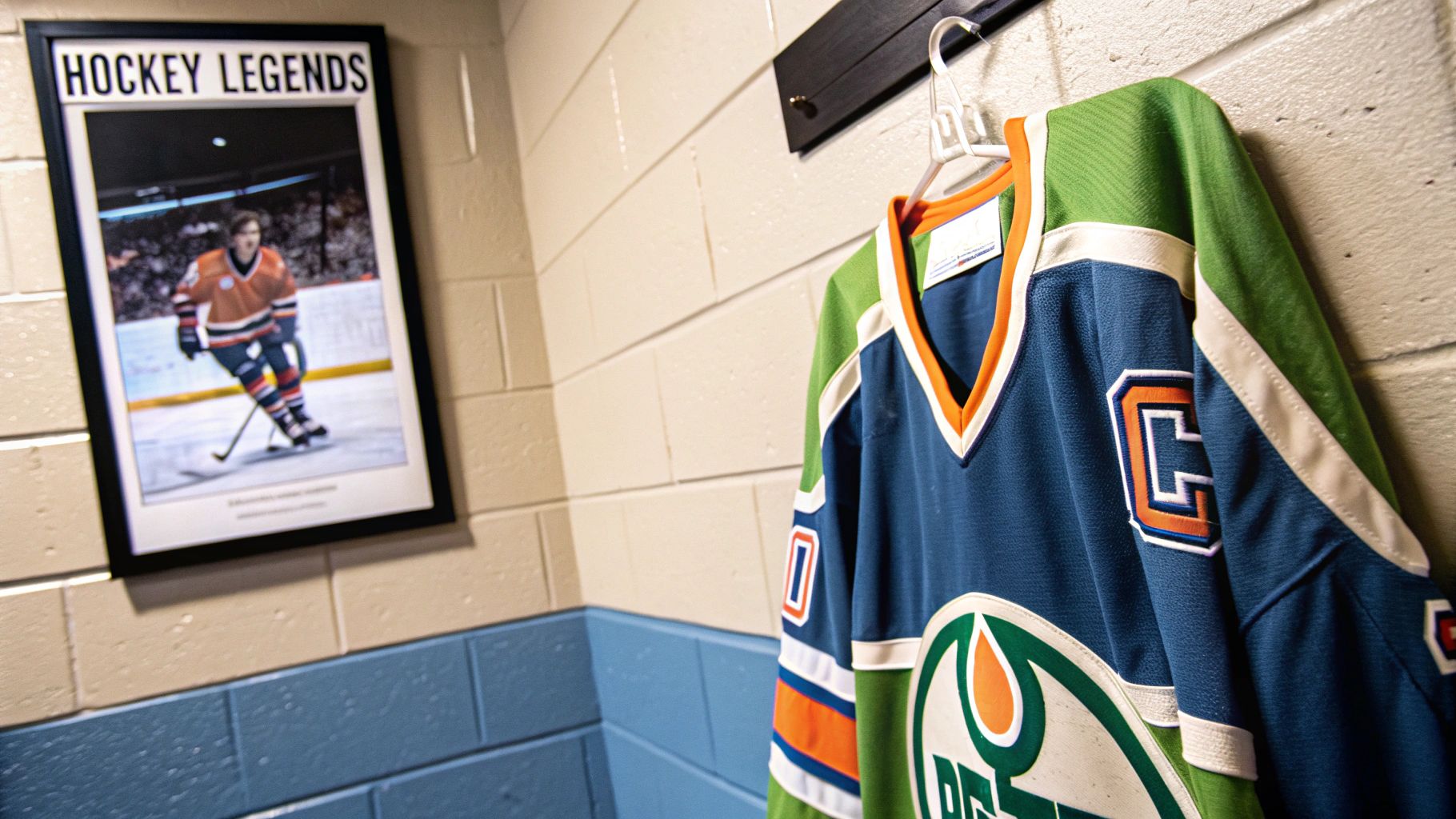
For a solid quarter-century, the Original 6 NHL was the only game in town. It was a closed club, a tight circle of six teams that defined professional hockey. But by the mid-1960s, you could feel the ground shifting. The world of sports was changing fast, and the league knew it couldn’t stand still. The era of six was coming to an end.
The NHL saw two big things on the horizon that forced its hand. First, rival leagues—especially the Western Hockey League (WHL)—were getting serious about competing for talent and fans. Second, those juicy American television contracts were becoming the new gold rush, and the NHL's small, northeastern footprint just wasn't cutting it.
To tackle both challenges, the league made a massive move. In 1967, it doubled in size overnight, blowing up the six-team model and expanding to twelve. This wasn't just adding a couple of new cities; it was a total reinvention of the league.
Navigating the Great Expansion Draft
The 1967 expansion welcomed six new franchises, completely redrawing the hockey map. In came the California Seals, Los Angeles Kings, Minnesota North Stars, Philadelphia Flyers, Pittsburgh Penguins, and St. Louis Blues. The problem? You can't just create six NHL-calibre rosters out of thin air, especially when the old guard holds all the best players.
The solution was the 1967 NHL Expansion Draft, but the rules were stacked heavily in favour of the established Original 6 NHL clubs. Each of those six teams got to protect their eleven best skaters and their number-one goaltender.
This meant the new expansion teams were basically picking from a pool of players the Original Six didn't want. They were left with a mix of aging veterans, career minor-leaguers, and unproven prospects.
The result was an instant, massive competitive gap. The new teams were designed to be inferior right out of the gate. The road to being taken seriously was going to be a long one. You can get the full story on this pivotal moment in our complete NHL expansion history guide.
A Case Study in Struggle
If you want a perfect example of how tough it was for the newcomers, look no further than the California Golden Seals. Their story is a classic case of an uphill battle. The Seals joined the league hoping to tap into the California market, but the lopsided draft rules hamstrung them from day one.
The Seals' whole existence was a bit of a strategic play—the NHL wanted to block the WHL from grabbing a foothold in California. While the team tried to build a local connection by keeping some players from the old San Francisco Seals (a WHL team), their roster was mostly made up of castoffs from the Original 6 NHL teams.
They simply couldn't compete. The on-ice struggles led to financial problems, and the franchise only lasted until 1976 before folding. It was a stark reminder of the power imbalance between the old guard and the new blood.
This created a clear divide in the league:
- The Old Guard: The Original Six kept their superstars and continued to dominate.
- The Newcomers: The expansion teams were left to fight for scraps, trying to build an identity while getting pummelled on the scoreboard.
The 1967 expansion officially closed the book on one of the most stable eras in sports history. It was a necessary move for the league’s survival and growth, but it also ushered in a new, more challenging chapter for the NHL, forever changing the landscape of the Original 6 NHL era.
The Lasting Legacy of the Original 6
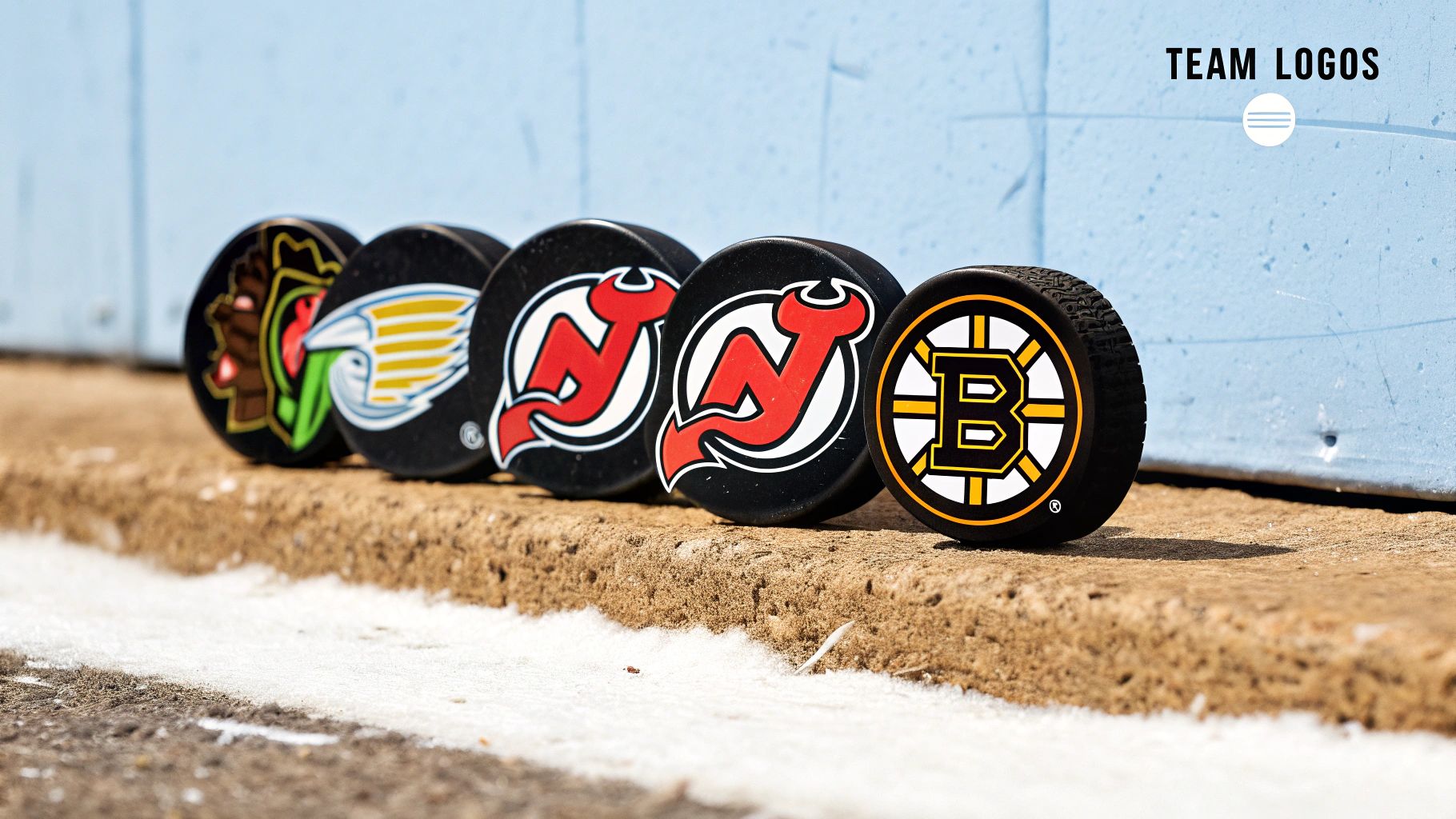
The 1967 expansion may have officially ended the 25-year “Golden Era,” but the story of the Original 6 NHL teams was far from over. Their influence didn't just fade away; it became the very DNA of the modern league. These six franchises aren't relics—they are living, breathing institutions that continue to anchor professional hockey.
Their most obvious legacy is their massive, die-hard fan bases. Allegiances to the Canadiens, Maple Leafs, Bruins, Black Hawks, Red Wings, and Rangers are passed down through generations like family heirlooms. It creates a level of loyalty and an electric atmosphere that newer franchises, no matter how successful, struggle to replicate.
These teams are still the league's heavyweights, driving revenue and commanding attention. When an Original Six team makes the Stanley Cup Final or gets a primetime slot, TV ratings and fan engagement almost always see a major spike.
Rivalries That Stand the Test of Time
Decades after the six-team era ended, the rivalries forged back then still burn hot. A Saturday night game between the Montreal Canadiens and the Toronto Maple Leafs isn't just another matchup on the schedule; it’s a cultural event steeped in over a century of bad blood. The same goes for Bruins vs. Canadiens or Red Wings vs. Black Hawks.
These games just feel different. They carry a weight that goes beyond the current standings, built on old stories, legendary players, and a shared animosity that keeps drawing in fans, both old and new.
The enduring power of the Original Six is that their brands are synonymous with hockey itself. Their iconic jerseys are recognized globally, and their presence in major league events like the Winter Classic is practically a requirement for maximum impact.
There’s a simple reason these franchises are consistently tapped for outdoor games and premier showcases: they guarantee an audience. Their deep roots and timeless appeal give the league a reliable foundation to build its biggest moments on.
The Cultural and Economic Bedrock
Off the ice, the cultural footprint of the Original Six is immense. Their logos are timeless symbols of the sport, worn by fans in cities all over the world. The stories of their dynasties and Hall of Fame players form the core of hockey's mythology.
Their financial impact is just as significant. The Original 6 NHL franchises are consistently ranked among the most valuable teams in the league, with brand equity built over nearly a century. That kind of stability provides a powerful economic anchor for the entire NHL.
In the end, the legacy of these six teams is all about continuity. They are the vital thread connecting the league's gritty, black-and-white past to its fast-paced, high-definition present. They aren't just part of the NHL's story—they are the story.
Common Questions About the Original 6
Even after digging into the history, a few questions about the Original 6 NHL teams always seem to surface. It's a legendary group, but the story has some odd quirks that can trip people up. Let's clear up some of the most common questions to give you the full picture.
Think of this as a quick reference guide to the six franchises that defined a quarter-century of hockey and still shape the league today.
Why Are They Called the Original 6?
This is easily the biggest point of confusion. The name "Original 6" makes it sound like these were the first six teams to ever join the NHL, but that's not quite right. The league actually started in 1917 with four teams, and a bunch of others came and went during those early, chaotic decades.
The name really refers to the 25-year stretch from 1942 to 1967 when the league’s membership held steady with just six teams: the Canadiens, Maple Leafs, Bruins, Black Hawks, Red Wings, and Rangers. After the Brooklyn Americans folded in 1942, these six were the only ones left.
Think of it less as the league's "original cast" and more as its most enduring lineup. That quarter-century of stability was so important for the NHL's identity that the name "Original 6" stuck, forever defining this group and their shared history.
Which Original 6 Team Has the Most Stanley Cups?
No debate on this one. The Montreal Canadiens are the most successful franchise not only in the Original 6 but in the entire history of the NHL. They've lifted the Stanley Cup a staggering 24 times.
Their dynasty was especially powerful during the Original 6 era itself.
- They won 10 Stanley Cups between 1942 and 1967.
- That run included a record that still stands today: five straight championships from 1956 to 1960.
The Toronto Maple Leafs are a distant second with 13 titles, followed by the Detroit Red Wings with 11. The Canadiens' long history of winning is a huge part of their identity and a key reason they remain one of the most storied teams in all of professional sports.
Are All Six Teams Still in Their Original Cities?
Yep, every single one. One of the most remarkable things about the Original 6 NHL legacy is just how stable they've been. All six teams still play in the same metro area where they first put down roots.
That's incredibly rare in pro sports, where teams moving cities is pretty common.
- Montreal Canadiens (Montreal)
- Toronto Maple Leafs (Toronto)
- Boston Bruins (Boston)
- Chicago Blackhawks (Chicago)
- Detroit Red Wings (Detroit)
- New York Rangers (New York)
This constant presence has allowed these teams to build deep, multi-generational bonds with their hometowns. It's also kept the historic rivalries forged during that golden era alive and well, making them feel just as intense today as they were 50 years ago.
At PuckNStick, we provide the in-depth statistics and analytics that bring hockey history and modern-day matchups to life. Explore our tools and player data today at https://www.pucknstick.com.
